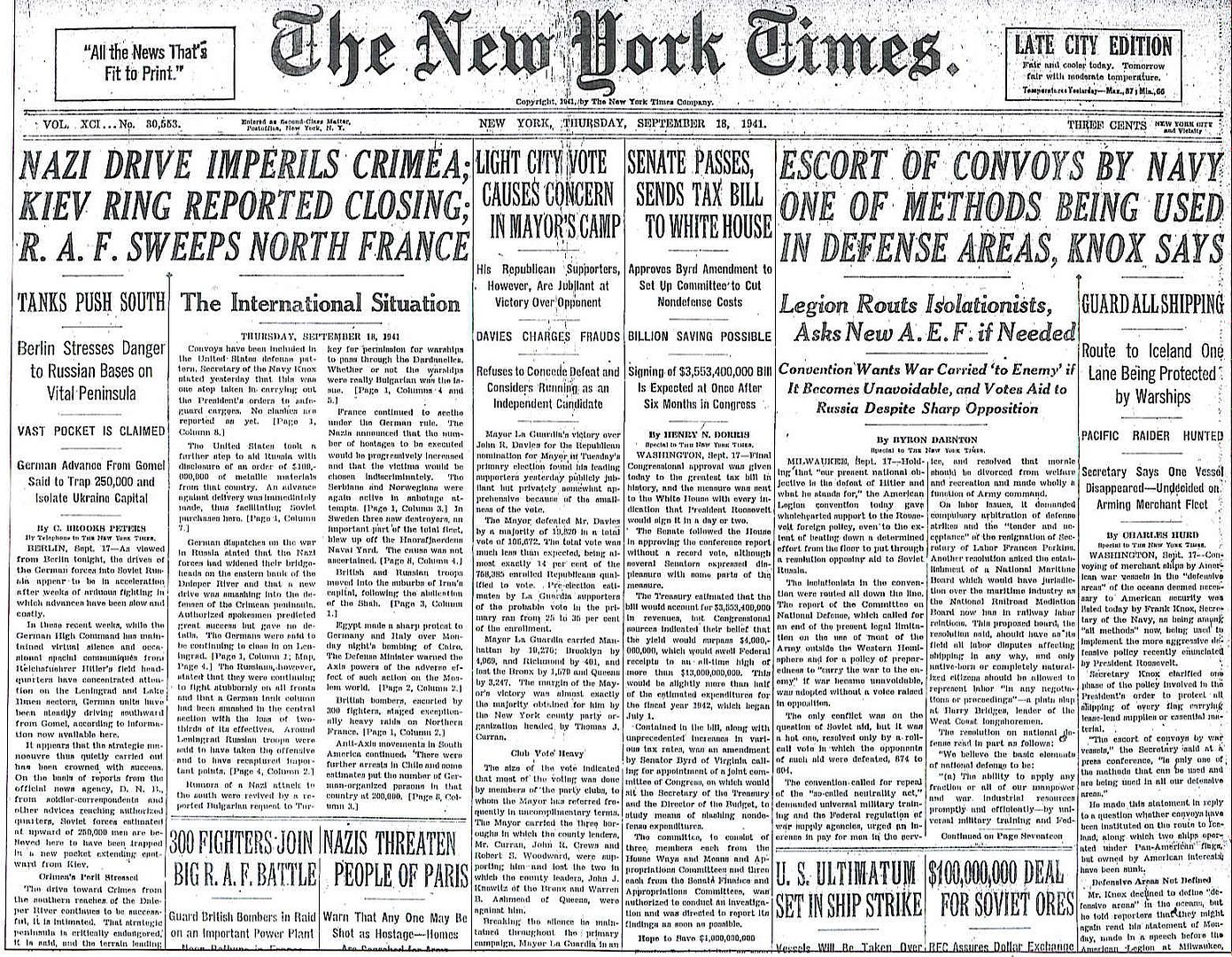
Posted on 09/18/2011 6:01:32 AM PDT by Homer_J_Simpson


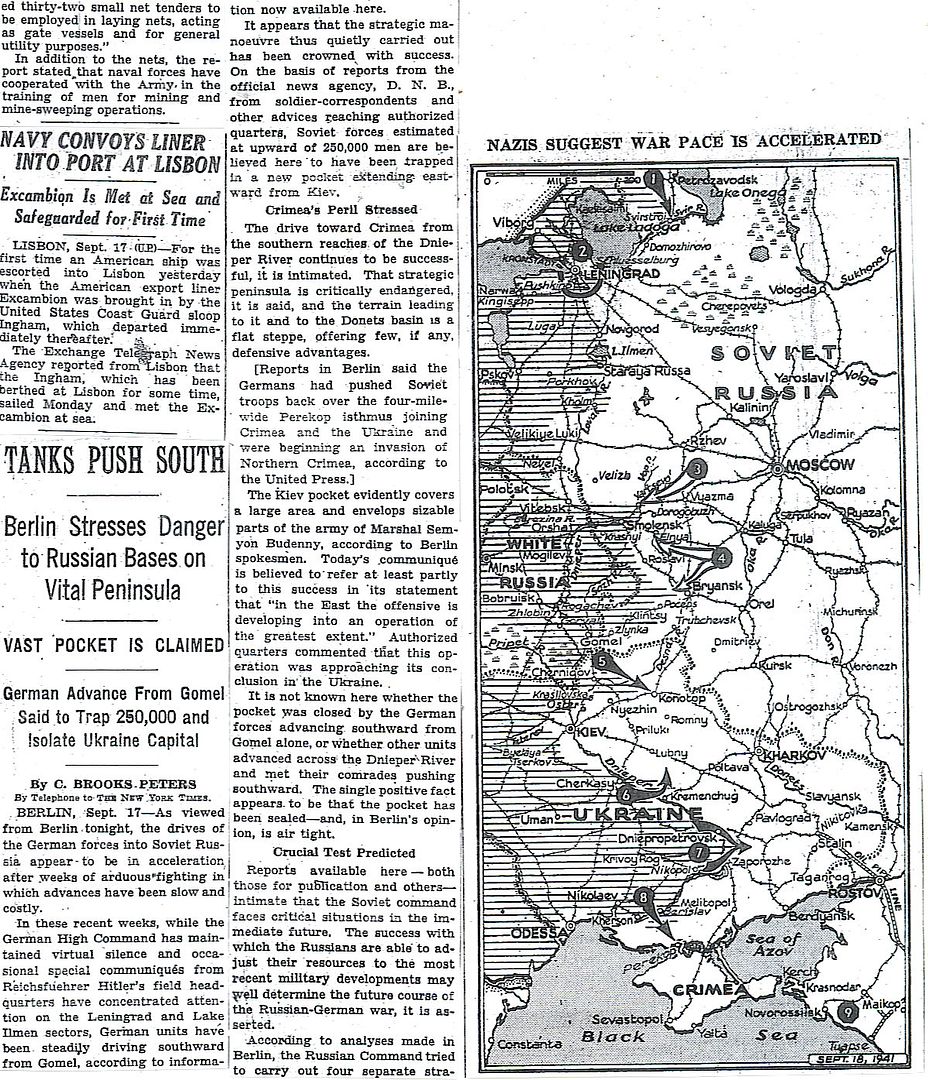
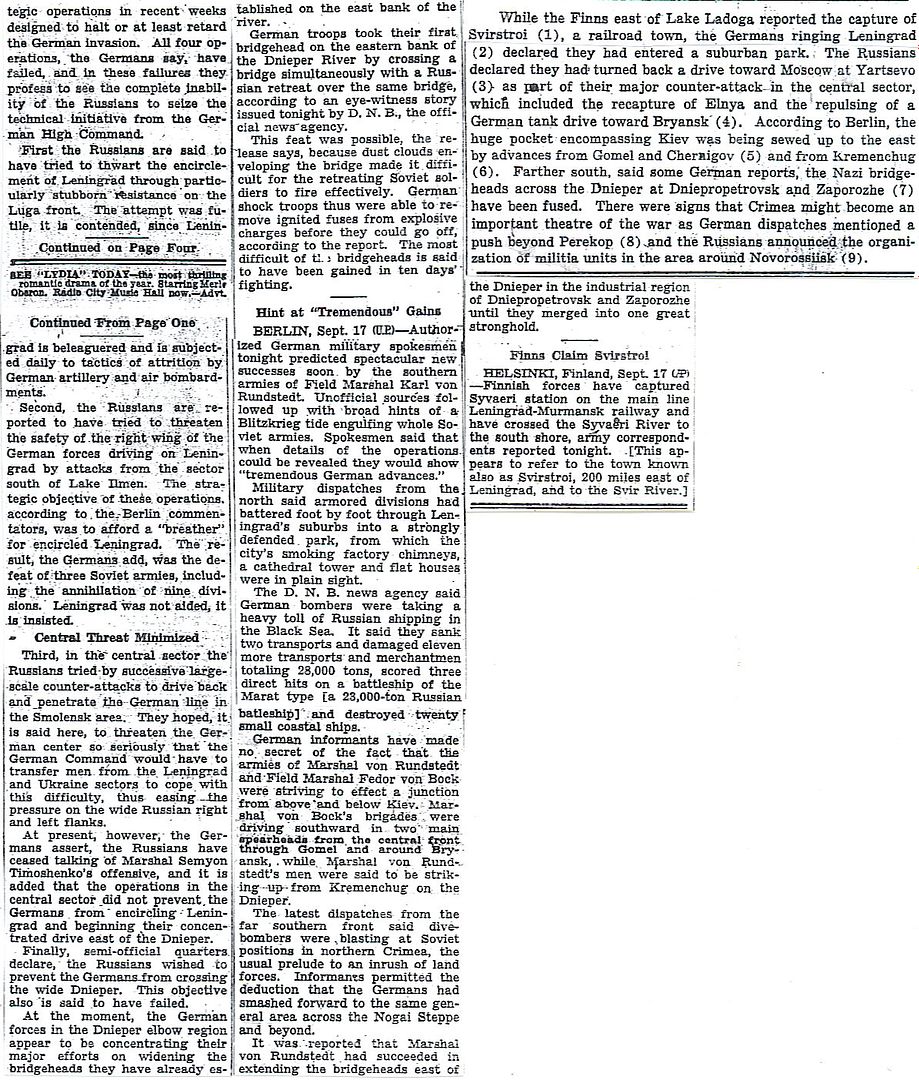


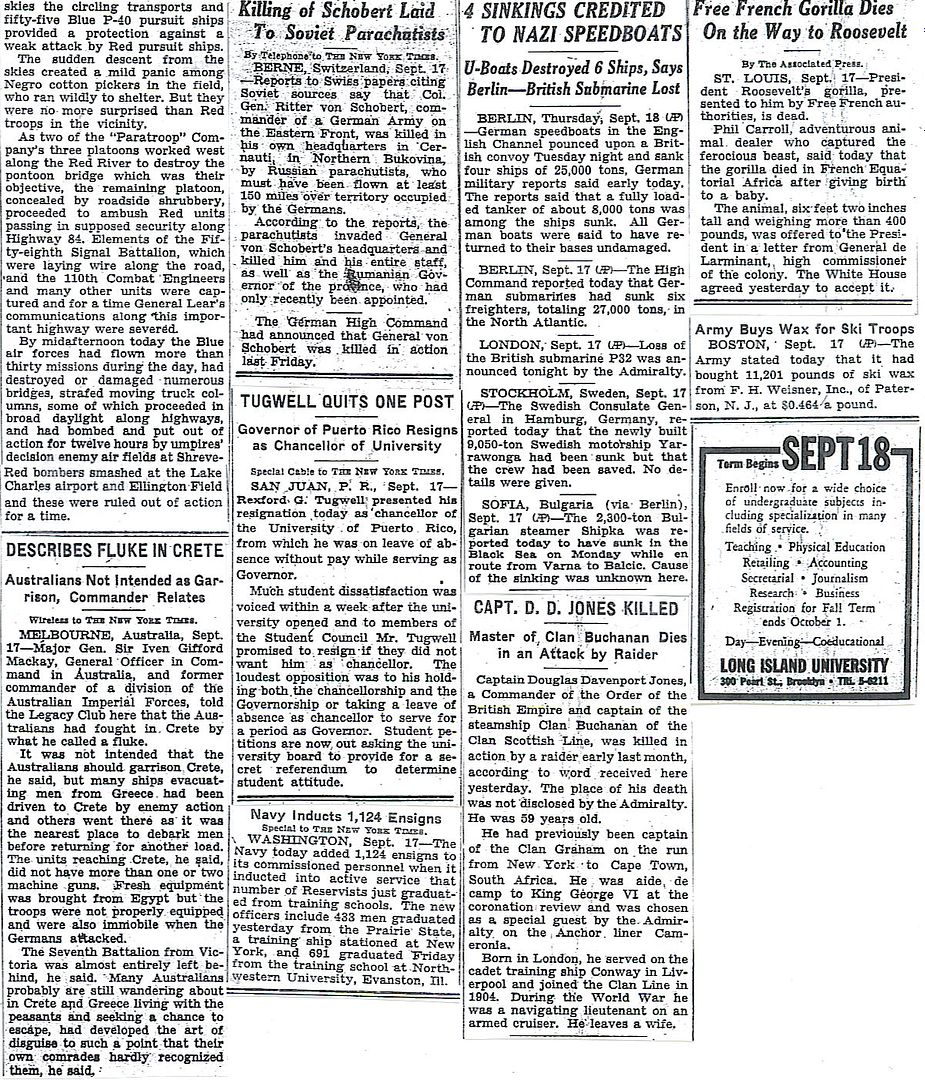
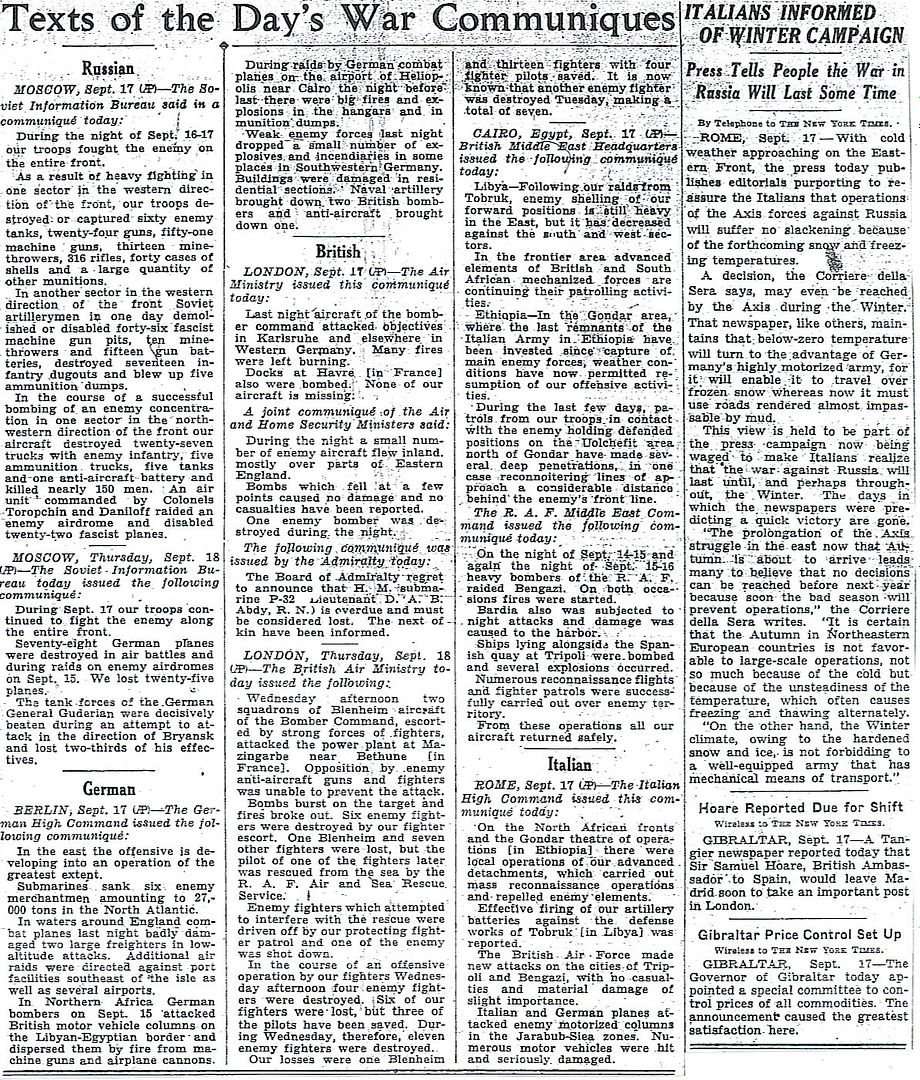
http://www.onwar.com/chrono/1941/sep41/f18sep41.htm
Congress asked to increase aid for Britain
Thursday, September 18, 1941 www.onwar.com
In Washington... President Roosevelt requests an additional $5,985,000,000 for Lend-Lease Aid to Britain from Congress.
http://homepage.ntlworld.com/andrew.etherington/month/thismonth/18.htm
Yesterday’s etherington post is available too. I will post it. - Homer
September 18th, 1941
UNITED KINGDOM says it will reveal the secrets of radio-location (radar) to the U.S.S.R. (Jack McKillop)
Submarine HMS Usurper laid down.
The remnant of convoy SC-42 arrived in Liverpool. The cargo lost from SC42 amounted to 15,050 tons of wheat, 14,400 tons of iron ore, 11,200 tons of steel, 9,300 tons of gas oil, 7,000 tons of other grains, 5,500 tons of sulphur, 4,275 tons of phosphates, 2,400 tons of pig iron, 2,100 general cargo, 525 tons of oats, and a large but unspecified tonnage of lumber. Two hundred and thirty-seven merchant sailors lost their lives in this battle. The battle for convoy SC-42 is considered to be one of the greatest convoy battles of the Second World War.
(Dave Shirlaw)
GERMANY: U-269 laid down.
U-214 launched.
U-456 and U-588 commissioned. (Dave Shirlaw)
U.S.S.R.: Ukraine: Units of Heeresgruppe Süd capture Poltava in the Ukraine. (Jack McKillop)
FINLAND: The Finnish Moscow embassy staff arrive home. They left Moscow on July 26 and spent from July 8th to August 31st stranded in railway carriages in the rail yard of Leninakan near the Turkish border. Denmark’s ambassador visited them at the end of July and observed that ‘the situation must be both physically and psychically very painful to Hynninen and his staff’. (In a meeting with Paasikivi shortly after returning Finland, Hynninen referred to 54 days spent ‘in difficult circumstances’ in Leninakan.) When they were finally able to leave, the journey continued through Ankara, Beograd, Vienna and Berlin to Lybeck, where they took a ship to Turku. (Mikko Härmeinen, 275)
MEDITERRANEAN SEA: Four Royal Navy U class submarines attacked a heavily escorted Italian convoy off the North African coast, sinking two large transports and damaging the third. They include the British submarine HMS Upholder which sinks the Italian troop ships Neptunia and Oceania; 384 people are drowned.
COMMONWEALTH OF THE PHILIPPINES: Navy Department approves Hart’s proposal to confine Asiatic Fleet to Philippine waters. (Marc Small)
CANADA: Minesweeper HMCS Sarnia laid down.
Corvette HMCS Port Arthur launched. (Dave Shirlaw)
U.S.A.: President Roosevelt requests an additional $5.985 Billion from Congress for Lend-Lease.
ATLANTIC OCEAN: For the first time, 5 USN destroyers escort an east-bound British convoy (HX-150). The 5 destroyers pick up the convoy about 150 miles (241 km) south of Newfoundland. (Jack McKillop)
Our Navy didn’t listen to The Brits advice(at first)about”Naval Escorts”for convoys and(as a result)we lost a lot of ships.It was really Admiral King’s fault!
anyone know what the truth is about how guderians tank army made out? NYT says 2/3 wiped out.
"From an illegal radio that's hidden in a large book, a member of the Dutch Resistance listens probably to a BBC broadcast.
Such broadcasts not only maintained the spirits of those in the occupied countries but also provided coded instructions for underground actions against the Germans.
Many individual Dutch were sympathetic to, and risked their lives to help hide, Jews from the Germans.
However, the Dutch government and police generally cooperated with the German occupation forces in rounding up Jews to be transported to their deaths in Poland."
The German Army in September 1941 was at the height of its military prowess, comprising a well trained and combat-experienced force that was led by competent military professionals. While the German troops and their leaders had begun to appreciate the tenacity of their Soviet opponents in the battle of Smolensk, the string of impressive victories reinforced the Wehrmacht’s belief in its innate superiority over their foes.
At the cutting edge of Operation Typhoon were the panzer corps, which combined armor, motorized infantry, motorized artillery, pioneers and motorized reconnaissance into a lethal combined-arms team. Combat losses and mechanical breakdowns had worn down the panzer divisions after three months of continuous fighting in the USSR, but Guderian's divisions still had 50 per cent or more of their tanks and equipment at the start of Typhoon, while Reinhardt's divisions had close to 80 per cent strength. Two panzer divisions - the 2nd and 5th – had just arrived at the front after reequipping in France and started Typhoon at full strength in equipment and manpower. These divisions were both assigned to the Fourth Panzer Army.
However, many of the German tanks were badly in need of depot-level repairs due to worn-out engines and transmissions. Hitler had ordered that all tank engine production should go for new vehicle construction rather than spares for existing units, and Army Group Centre received only 350 tank engines just prior to Typhoon to bring some vehicles back into service.
By the third month of Barbarossa, the Ostheer's infantry divisions were exhausted after a series of endless marches and pocket-reduction battles.
Most divisions had 75-80 per cent strength in personnel but material losses had been fairly light.
Although still armed with the outdated Pak 36 -37mm anti-tank gun, the German infantry had begun to receive the better Pak 38- 50mm anti-tank gun. The Germans were also beginning to experiment with self-propelled anti-tank guns and the 8th and 28th infantry Divisions in Ninth Army each received ten self-propelled 88mm guns on an SdKfz 8 halftrack chassis. Furthermore Army Group Center had 14 assault-gun battalions with about 350 StuG llls, which gave the infantry corps more firepower.
Army Group Center’s artillery played an important role in Typhoon. Artillery was still necessary to achieve breakthroughs against fixed defenses and was also critical in defeating the all-too-frequent Soviet counterattacks. Indeed, the German division artillery regiment provided about 60 per cent of the firepower in that formation and as infantry losses mounted, the Germans became increasingly reliant on their artillery. At the start of Typhoon, Army Group Center had amassed about 4.000 heavy caliber weapons {including 2300 105mm, 1,000 150mm, 184 210mm guns and 270 Nebelwerfer rocket launchers}. Yet only 1/3 of the German artillery was motorized, the rest being horse-drawn, just as it was in 1918. While German artillery losses thus far in Barbarossa had been light, its effectiveness was plagued by mobility problems caused by the shortage of trucks and Russia’s primitive roads. Thousands of trucks and horses had been lost before Typhoon even started, leaving the German artillery with a narrow margin of mobility.
The other vital part of the combined-arms team was Luftwaffe ground support. The Luftwaffe had been providing excellent close air support to the army for the first three months of Barbarossa but by October heavy losses and lack of adequate maintenance at forward airstrips had reduced this formidable force. For Typhoon, Kesselring’s Luftflotte 2 had about 549 aircraft operational-approximately 230 bombers (He 111, Do 17 and Ju 88) in 13 Kampfgruppen, 190 fighters (Bf 109) in nine Jagdgruppen and about 120 ground attack aircraft (Ju 87 Stuka and Bf 110) in eight groups. General von Richthofen’s VIII Fliegerkorps had developed into the premier close air support organization in the Luftwaffe and was a major combat multiplier for the Germans. The Luftwaffe also had detachments from II Flak Corps, equipped with the powerful 88 mm Flak 36 dual purpose gun, attached to each of the panzer groups.
Army Group Center’s main weakness was logistics, which had been parlous from the beginning of the campaign.
Only two Eisenbahn regiments for repairing captured Soviet rail lines were assigned to support Army Group Center and they soon proved to be inadequately manned, trained and equipped. While the Eisenbahn units were capable of regauging up to 20 km of the Soviet broad-gauge rail line per day, they also had to rebuild damaged bridges and repair various train facilities. Even once repaired, the rail lines supporting Army Group Center were operating far below capacity: instead of receiving 30 trains with about 450 tons of supply each day, Army Group Center typically received only 12-20 in the autumn of 1941. Gross inefficiency in the German logistical pipeline in Poland, caused by competing commanders in charge of railway and logistic depots, further contributed to bottlenecks that starved Army Group Center of vital material. A classic example of these bottlenecks was the issue of winter clothing: contrary to popular myth, Hitler had not forbidden the issuing of winter clothing. However, due to the limited rail capacity of the lines going into occupied Russia, winter clothing was assigned a much lower priority than fuel or ammunition. Much of the clothing was stockpiled in depots in Poland awaiting transport.
At the start of Typhoon, Army Group Center had four main railheads supplying its six armies: Nevel, Smolensk, Roslavl and Gomel. The German logistic pipeline could operate no more than 100 km from these railheads and relied primarily on trucks to bring supplies up to the forward units. Army Group Center had one Grosstransportraum or motor transport regiment, with about 1,500 vehicles and a capacity of 6,500 tons, to transport supplies to the corps, which then used organic transport to supply their own divisions. Luftflotte 2 also had three transport groups with Ju 52 transport planes capable of carrying about 200 tons that could also supply air resupply to the army if necessary. However, Army Group Center was experiencing fuel and ammunition shortages even before the onset of bad weather because of the inability to bring forward sufficient quantities of supplies from the railheads: Army Group Center’s 70 divisions required in excess of 13,000 tons of supply per day but the truck and horse transport columns were incapable of filling more than 65% of this requirement. As the distance from the railheads to the front line increased and inclement weather arrived, German supply capabilities diminished to less than one third of requirements.
To make matters even worse, the Wehrmacht was running dangerously low on fuel and ammunition after three months of sustained combat in the USSR. About 40% of Germany’s fuel stocks were consumed during Operation Barbarossa and consumption was fast outstripping production. Ammunition was also in short supply, since Hitler ordered a major reduction in production following the fall of France despite planning for a major campaign against the USSR. By the start of Typhoon, demand for artillery ammunition was exceeding production by a ratio of more than 11:1. During Typhoon, German industry produced 774,000 rounds of large-caliber artillery ammunition but expanded over 5 million rounds. By the end of 1941, Germany’s stock of artillery ammunition had fallen to its lowest point of the war.
Nor were Army Group Center’s personnel or equipment losses being made good. Although the German Replacement Army was training about 128,000 men per month, the Ostheer was receiving only about one replacement for every two men lost.
Guderian’s Second Panzer Group had suffered 55,380 casualties by 22 November, but it had only received 29,589 replacements. Instead, Hitler was sending many of the replacements to new divisions being formed in occupied Western Europe. German armor production in late 1941 was only slightly ahead of losses but most of the new tanks were also going to new units in the West. Army Group Center’s panzer divisions were only receiving about one replacement tank for every eight lost in combat.
In mid-September 1941 OKH authorized the transport of 307 tanks from reserve stocks to replenish Army Group Center’s armor for Typhoon, but these were the only substantial armor replacements received during the battle for Moscow. Thus, even before the onset of winter, Army Group Center was heading into the decisive battle of the war with under-strength units and worn out equipment.
The failure of the OKH and OKW to marshal all its available resources and weight the main effort towards Moscow was a major reason for the failure of Typhoon. When Germany needed every soldier for the decisive moment in Russia, some 34 divisions with almost 900,000 troops were left sitting idly in Western Europe guarding against a non-existent British threat. While the Soviet Stavka was able to direct 62 division equivalents to rebuild the shattered Western front in October-November 1941, the only new units received by Army Group Center during Typhoon were the Legion des Volontaires Francais (LFV) and a few paratroop battalions.
Yet the Germans had five idle mountain divisions in Norway and Finland that were well equipped for cold weather operations.
The Netherlands had their own SS, and contributed one of the largest foreign contingents to the Waffen SS.
“...thus leading the world and Australia to suppose that we are fighting our battles with Dominion troops only.”
Well, yes.
All the tank divisions were in desperate shape by this point, and even earlier for that matter. In the first month of BARBAROSSA alone, Guderian went from an operational force of 953 tanks to just 286. Of those remaining operational tanks, 132, were old Mark I and Mark IIs.
Now “wiped out” is a tricky word here though. The numbers above represent the tanks operational in late July 1941, but does not represent any indication that the “down” tanks were beyond repair which would make them truly wiped out. The problem at hand though was getting the necessary parts to repair them. If you recall, last month Hitler finally agreed to have 400 tank engines shipped to the Russian front to repair their forces along with only 35 new tanks. Guderian himself would have needed all 400 engines just to get to 60% operational strength. Of course he did not get all 400 and in fact 400 engines were not even the total that made it to the front anyway. It was closer to around 250.
So this report, though designed to be optimistic towards the Russians as all the reports on this front have been in the times thus far, is perhaps even an understatement.
nice post, thanks man
Disclaimer: Opinions posted on Free Republic are those of the individual posters and do not necessarily represent the opinion of Free Republic or its management. All materials posted herein are protected by copyright law and the exemption for fair use of copyrighted works.